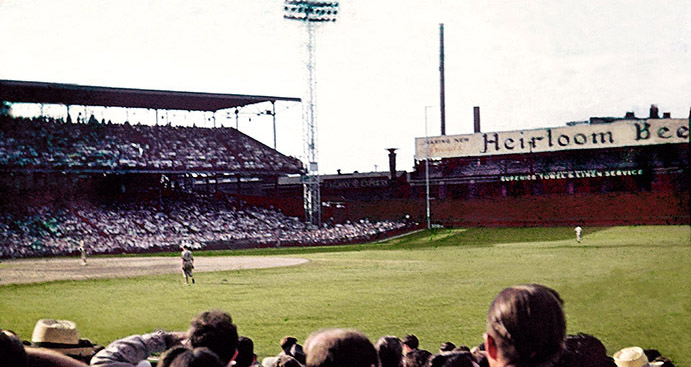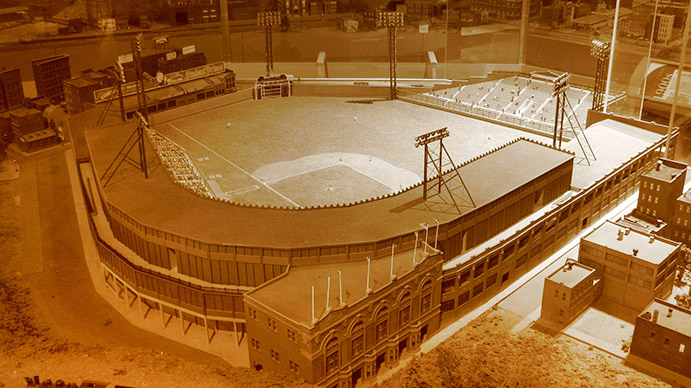The Ballparks
Crosley Field
Cincinnati, Ohio
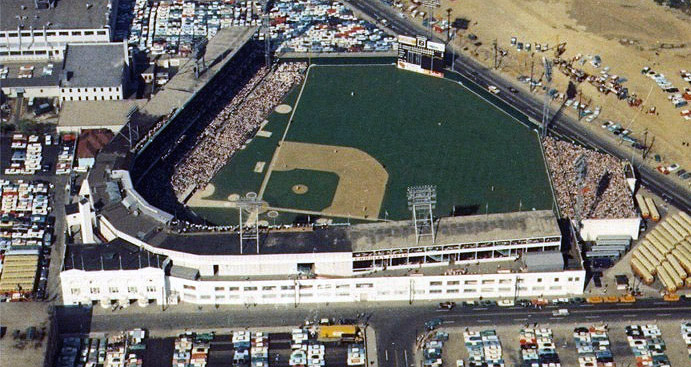
Neither floods nor darkness nor baseball’s most unique warning track could keep the loyal bugs of the Queen City from worshipping their kings in a cherished urban castle where every National League campaign was kicked off. While Crosley Field may have lacked the exterior glam, its interior radiated lush green grass, intriguing wall quirks and romantic views of the environs beyond.
In its heyday, Crosley Field was the epitome of nostalgia, the perfect image you would envision when espying one of those beautiful illustrations recreating the ballparks of yesteryear. The gorgeous green field, prepared by one of the majors’ premier groundskeepers, was as good as it got. The asymmetrical positioning of the outfield walls and its various heights, bounded to the street grid outside, created adventure for the players and entertainment for the fans. The neighboring brick-clad businesses, adorned with billboards, dared sluggers over 400 feet away to “hit it here.” The Cincinnati hillside beyond completed the package, bringing a fitting, vernal contrast to the urban chaos below.
Crosley Field was more deserving of its predecessor’s name, the Palace of the Fans. It certainly felt like one for the customers—as well as the players who performed there, the media who covered them and the city that embraced the Reds every Opening Day, a longstanding tradition so revered that tickets were scooped up before Christmas and often used as the perfect stocking stuffers.
Crosley was full of unique character. It was the first yard to stage a major league game under the lights. It was the first to install air conditioning in the dugouts and press box to combat the stifling Midwest summer heat. It contained a cozy seating capacity that rarely surpassed 30,000 and, in its later life, sported a cozy playing field where muscular sluggers salivated, snipped the sleeves and made life miserable for pitchers. Most particular to Crosley was its idea of a warning track, a grassy incline that kept outfielders from crashing into walls—but not from having their legs look like spaghetti as they unexpectedly gave in to the hill. From a masculine point of view, injury must have been preferable to embarrassment.
The Cincinnati Reds were never a juggernaut at Crosley—the Big Red Machine was just starting to crank itself into high gear when the ballpark’s gates closed in 1970—but the joint rarely lacked for providing its share of baseball history. Crosley was the place where the Chicago Black Sox’ Eddie Cicotte opened the 1919 World Series by plunking the Reds’ Morrie Rath, a signal to gamblers that the fix was on. It’s where the Schnoz took a “snooze” 20 years later in the Fall Classic, when Hall-of-Fame catcher Ernie Lombardi was knocked dazed and confused from a collision at home plate by the Yankees to help seal the Reds’ fate. It’s where Leo Durocher rounded the bases on a bunt at the 1938 All-Star Game. It’s where Johnny Vander Meer threw the first of his two straight no-hitters, and where Ewell Blackwell came within two outs of matching him nine years later. It’s where the Brooklyn Dodgers’ Pee Wee Reese put his arm around teammate Jackie Robinson as a signal to racist hecklers that the majors’ first modern African-American ballplayer was here to stay. Fans at Crosley witnessed Hank Aaron’s 3,000th hit, Stan Musial’s last, and Pete Rose’s first.
Roman Times.
Baseball activity preceded Crosley Field by 28 years at the corner of Findlay and Western. League Park, a popular ballpark name during the 19th Century (especially in Ohio), was built in 1884 on a former brickyard two years after the Reds began business in the American Association. It was your typical pre-modern structure with a covered wooden grandstand that, all too unfortunately, faced toward the northwest and a lowering afternoon sun that blinded hitters and fans. To remedy this, home plate was swiveled 90 degrees in front of a new grandstand built in the southwest corner in 1894, four years after the Reds had moved over to the National League. But when the new stands burned down in 1900, they had to reorient back to the old grandstand—which the Reds serendipitously never tore down—until a replacement structure was constructed.
That new structure would be unlike anything seen in baseball, before or since; had the Roman Empire ever built a ballpark, it would have looked something like this. With all of its architectural energy focused on the inside—the exterior was rather rudimentary—the highlight of League Park’s new edifice was a neo-Classical façade topped by a triangular pediment featuring a stately name plate with “Cincinnati” etched in classical a Roman-style font. From there the structure elegantly spread out with square pillars and ornate touches; semi-circular, opera-style boxes stuck out from the front of the grandstand, adorned with Egyptian petroglyph décor, floating over a small field level that was merely three rows deep and housed some of the rowdier, beer-swigging fans. The ballplayers, with no dugouts to hide in, had to absorb the torrent of verbal abuse, sometimes at close range.
The Palace of the Fans—the name eventually given to the ballpark as ‘League Park’ was frowned upon as too generic—was so stately and proud a setting that it demanded seasonal upkeep to maintain its dignity. It never got it. Before it even completed its first decade, The Palace fell badly into disrepair, and inspectors warned that it might become too hazardous to continue to inhabit. A fire was said to damage the ballpark in 1911, but by then the Reds were ready to blow the whole thing up and start from scratch.
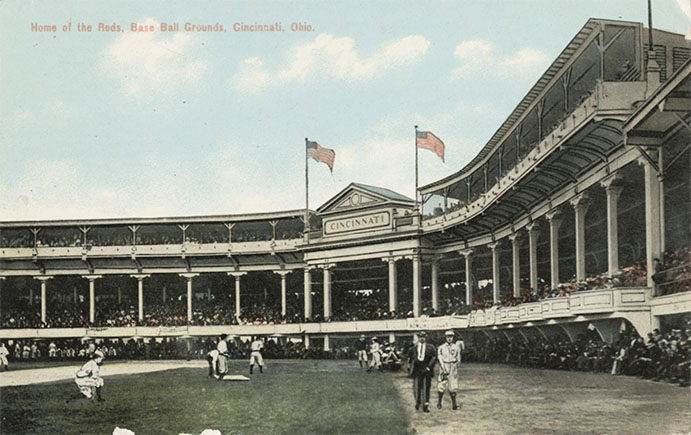
Crosley Field was preceded at the same location by the Palace of the Fans, an unusual, highly Romanesque structure. It quickly fell into disrepair and didn’t last 10 years. (From the Collection of the Public Library of Cincinnati and Hamilton County)
Welcome to Redland.
Taking charge of the situation—and the Reds in general—was Garry Herrmann, one of three men who bought the team in 1902 and eventually emerged as its primary lord. A kindly man, Herrmann was so beloved by the rest of baseball that he was quickly named by both the National and American Leagues—both of which were far from kind to one another at the time—to head the three-man National Commission, the forerunner to baseball’s commissioner. In fact, when he rebuilt the Reds’ ballpark for 1912, Herrmann refused to accept the locals’ suggestion to name it after himself, as other owners had done with recently opened venues. He preferred League Park; “God, no, anything but” was the response. So Herrmann went with Redland Field, as a provincial tribute to the team and its fans.
In contrast to other steel-and-concrete ballyards of the time that featured majestic entrances perfectly framed on a street corner, Redland Field was architecturally bland and askew—save for its main entrance, a rectangular, three-story brick red building that morphed out of the ballpark bowl with traces of elegance. It was a subtle nod to the Palace of the Fans by topping each end of the building with a stretched triangular pediment, though the building wielded a more Baroque influence. The building’s upper two floors would house the Reds’ front office; for a time, it also partly served as the Reds’ clubhouse. Its function as a business building partially hiding a ballpark has been copied with modern venues such as Seattle’s Safeco Field and the Reds’ current home at Great American Ball Park.
Inside, a covered grandstand stretched from pole to pole and was topped by a covered second deck extending just beyond the infield on both sides. The only room for bleachers lay in right field, stretching toward center field before being cut off by Western Avenue, slicing diagonally behind. A separate, more petite entry into these seats borrowed from the façade of the main entrance, triangular top and all.
A day after the Titanic set sail for America, Redland Field opened for the masses in Cincinnati; needless to say, the ballpark would outlast it by six decades. Redland Field officially sat 20,000, but ticket demand was so intense that 6,000 additional fans were accommodated by flooding the back of the outfield and portions of foul territory. The Reds christened the facility in comeback fashion, trailing early 5-1 before bouncing off the green canvas and knocking out the visiting Chicago Cubs for six fourth-inning runs, adding three more later in a 10-6 victory. Both teams set the pace for a record year of triples in baseball by combining for seven three-baggers, a number that would never be surpassed in the 4,543 games to follow at Redland/Crosley over the next 58 years.
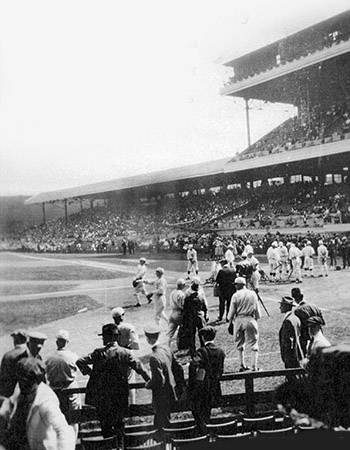
The Chicago White Sox warm up at Redland Field before the start of the infamous 1919 World Series, which the Reds won when White Sox players conspired to throw the series for money. (The Rucker Archive)
The Reds, trying to shake seven straight years of losing records, seemed to get an emotional boost from the opening of Redland Field, and it peaked on May 19 when the park was formally dedicated with the Reds tipping the powerful New York Giants before 28,000 in 10 innings, 4-3, to improve to 22-6 on the year. The victory was followed by a gala dinner honoring Garry Herrmann and attended by both league presidents (including AL boss Ban Johnson, taking a break from the ongoing saga of Detroit players boycotting over suspended teammate Ty Cobb), Giants manager John McGraw, Pennsylvania Governor (and future NL president) John Tener, and two members of the legendary 1869 Cincinnati Red Stockings that went undefeated as baseball’s first pro team. After the food settled in, so did reality; the Reds barely played over .500 the rest of the season at Redland, stunk on the road, and finished at 75-78. They’d have to wait another five years for that elusive winning campaign.
Redland Field fit in perfectly with the Deadball Era, yielding numerous doubles and triples while the few home runs recorded were entirely of the inside-the-park variety. In fact, it took over nine years for someone to finally clear the outfield wall on the fly when, on June 2, 1921, the Reds’ Pat Duncan sailed one over the left-field fence and hit a policeman on the other side; thank goodness Duncan was playing for the home team, or he might have been arrested for assault. Instead he got the glory—and even then, it perhaps should have been nothing more than an asterisk. That’s because a month earlier, a Negro Leaguer named John Beckwith, playing for the Chicago Giants against the Cincinnati Cuban Stars—the first Negro League outfit to rent an existing major league ballpark—beat Duncan to the punch by also sending a ball beyond the left-field wall.
One would have expected the balls to fly over the Redland Field wall with increased regularity as Babe Ruth and a host of other reinvented sluggers blasted the Deadball Era to oblivion in the 1920s, but the yard held firm. This, even after the Reds moved home plate closer to the outfield in 1927 to make room for an additional 5,000 seats, shrinking field dimensions some 15 to 25 feet across the board. Rarely were more than 20 homers recorded in a typical year at Redland between both the Reds and their opponents; only six were logged in both the 1920 and 1924 seasons. It’s little wonder that some of the best pitching numbers from this otherwise offensively thunderous decade came from Cincinnati, where the Reds thrice led the NL in team earned run average behind Eppa Rixey, Pete Donohue and Cuban native Dolf Luque.
The Schwab Squad.
Pitchers weren’t the only ones happy at Redland Field during its early years. Fielders praised the playing field for its near-prefect condition and constant ability to yield true hops—and that was saying something in an era when ballfields were frequently beat up and unpredictable. The man behind Redland’s upscale turf was Matty Schwab, one of the game’s A-list groundskeepers who learned the trade from his father, who himself had been preparing the field for the Reds as far back as 1884. Schwab took over in 1904 and remained on the job all the way through 1962, enduring more than his fair share of challenges—most of which involved the Ohio River.
Cincinnati has always been at the mercy of the mighty Ohio, which borders the southern end of the city. Various measures have been put in place to avoid the inevitable moment when the waters rise beyond the river’s means, but when the winter snows and ice melts too fast, there’s little anyone can do about it. Crosley Field sat a mile north of the Ohio, but closer by was Mill Creek, which typically flowed toward the river—except in times when floodwaters pushed backward and over its banks. Matty Schwab had designed one of the majors’ first underwater drainage systems at Redland Field, which was a blessing in that it helped quickly dry out the field after a hard rain—but it was a curse when floodwaters found their way into the piping and pushed their way up and onto the field.
Floods became an unwanted tradition at Crosley Field. Over the ballpark’s first 30 years, the field became a lake 16 times. The worst and most celebrated of the floods came in 1937 when the water level rose 21 feet above the playing surface, almost inundating the entire lower level of seats. Even though many of the floods took place in the winter before Opening Day, that Schwab was quickly and efficiently able to prep the field back into game-ready shape became a testament to his gift of groundskeeping. “When you walked out on that field,” recalled former Red Jim Greengrass, “you were in high cotton.”
Not all of the floods were of nature’s making. After a rough outing in 1964, rookie Reds pitcher Billy McCool lost his cool, angrily ripping out the dugout water fountain and severing a pipe that allowed water to spill into the dugout and onto the field. Maintenance crews had to hurry over to fix it.
Schwab showed off his multiple talents by also designing the ballpark’s original scoreboard, which for the first time included team lineups—first by position, then by uniform numbers once players began wearing them on their backs in the 1930s. So impressed were other teams that five of them—including the New York Yankees and Brooklyn Dodgers—asked Schwab to create their scoreboards as well.
Eventually, Schwab passed on his talents to his sons; one of them even took on the role of ad hoc scout and tipped the Reds on a young college ballplayer named Ted Kluszewski in the late 1940s. Ironically, Schwab passed away on April 8, 1970—The year the Reds departed Crosley Field.
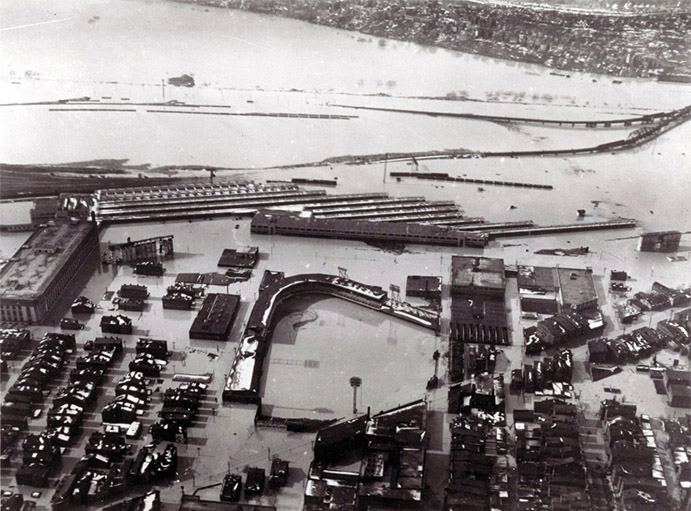
Floods emanating from the nearby Ohio River became a chronic hazard at Crosley Field; this is one of at least 16 that inundated the ballpark during its lifespan.
The Ramp to Ridicule.
Of the many ingenuities credited to Schwab, one was not Crosley Field’s warning track incline. While all other major league ballparks used a 15-foot strip of dirt to tip outfielders of an imminent collision with the wall, Crosley elevated the turf four feet at a 15-degree incline. It most certainly got the players’ attention, often disrupting their pursuit of a deep fly as their legs collapsed from the sudden, unexpected ascent.
The incline got the best of them; even Willie Mays, who some consider the greatest defensive outfielder of all time, once found himself stumbling about on the hill. But perhaps the incline’s most memorable victim was Babe Ruth—overweight, fading and toiling for the Boston Braves—who on May 28, 1935, suffered a humiliating pratfall on the grade. An angry Ruth picked himself up walked off the field; he retired three days later.
One of the incline’s benefits is that it allowed for better seating when an overflow crowd warranted it. Shorter people need not take the front row; the incline allowed for an informal picnic-style set-up not unlike what’s seen at many spring training ballparks today.
The incline did not trend well within the majors. All other ballparks stuck with the traditional warning track. When Oriole Park at Camden Yards was being idealized in Baltimore, Hall of Famer (and former Red) Frank Robinson lobbied for an incline; the Orioles said no thanks. When Great American Ball Park was being designed, the incline was considered, for old times’ sake. The Reds ultimately said no thanks. Only at Houston’s Minute Maid Park (opened in 2000) did a semblance of an incline get included into the final product, a small area behind center field named after former Reds executive (and then-current Astros front office head) Tal Smith. It lasted 17 seasons before the Astros got rid of it.
The warning track incline is highly apparent in this shot taken from the field level at Crosley Field in 1946. The incline concept was never fully adopted at any other major league ballpark. (Wikimedia—Rob Lambert)
Crosley nee Redland.
A frail Garry Herrmann sold the Reds in 1927 to club executive C.J. McDiarmid, who flipped the franchise over two years later to Sidney Weil, a champion on the stock market circuit. Unfortunately for Weil and the Reds, the market crashed six months after he bought, and he indefinitely struggled to maintain cash flow. The Reds themselves crashed as a result, landing into the NL basement where they stayed for four straight years. When enterprising young general manager Larry MacPhail was brought into the Cincinnati front office in 1933, his job became twofold: Rebuild the roster and find a new owner. He found the latter in Powel Crosley, a local manufacturing king of cars, radios and appliances. Apprehensive at first, Crosley had to be talked into buying and only accepted once he understood the gravity that if he didn’t buy, someone outside of town might—and move the franchise.
Crosley was cordial and wise enough let the baseball men run the baseball side of things, but he also had an ego to bruise; he once bought a Cincinnati radio station and pumped up the wattage to 500,000 before the FCC told him to dial it way back. With the Reds, he didn’t hesitate to rebrand Redland Field as Crosley Field, irking those who recalled Garry Herrmann’s more humble ballpark naming philosophy. And he rid the outfield wall of all ads—replacing it with a punctuation of his own products, most memorably a large-scale Crosley refrigerator atop the scoreboard, leading to public cries of shamelessness.
A Bright Idea.
The team Crosley inherited was a mess, and the fans were no longer responding; by 1934, only the derelict Philadelphia Phillies, playing at the decrepit Baker Bowl, drew fewer fans than the Reds (who averaged less than 3,000 a game). With MacPhail’s encouragement, Crosley tried a new wrinkle: Night baseball. It wouldn’t be the first time it had been tried in organized ball, having been used in a few minor league towns; in fact, it wouldn’t be the first time in Cincinnati, as the old Palace of the Fans was once lit up for a 1909 contest with local amateur teams performing as guinea pigs, with mostly murky results. The 14 arc lights were faint candlelight compared to what the Reds now had in mind: Eight towers sporting a total of 600 light bulbs, flooding the field with a million watts of General Electric’s finest.
The first scheduled night game, on May 23, 1935, was rained out; perhaps the Almighty, who went to all that trouble to create light, didn’t like the concept. Anyway, conditions for the next night were clear, albeit chilly, as President Franklin D. Roosevelt pulled a ceremonial switch back at the White House that lit up Crosley Field. The event was a victory for the Reds between the lines—Paul Derringer went the distance as the Reds edged the Phillies, 2-1—and at the gate with a crowd of 20,422. But baseball was the bigger winner on the evening, as witnesses marveled at how much easier it was to follow the white ball against the night sky. For the year, the Reds scheduled seven games under the lights and drew 130,000, nearly two-thirds of their total gate from the year before.
Some players didn’t quite see the light. Babe Ruth, perhaps in sync with the game’s other party animals, likely felt that playing at night would cut into the evening and the postgame pursuits of libations and lust. Most other teams remained weary themselves—for different reasons, obviously—and were slow to follow, but the Reds and Crosley Field clearly showed that night baseball in the majors was here to stay.
There were some kinks to be ironed out with the lights. Crosley Field was most certainly the first ballpark to put up a batter’s eye for night games when they placed a swath of canvas over the center field wall to block out city lights that distracted hitters. Typically, the Reds took the canvas down for day games, but one day in 1940 they forgot about it—and it cost them a win against Brooklyn when Harry Craft launched a ninth-inning drive that hit the canvas, robbing him of a game-winning homer. The Reds complained, but umpires simply shrugged and said, hey, don’t blame us—you’re the guys who left the screen up. Cincinnati lost in 11 innings, 4-2, and took out its anger the next day by piling up a ballpark-record 23 runs against the Dodgers.
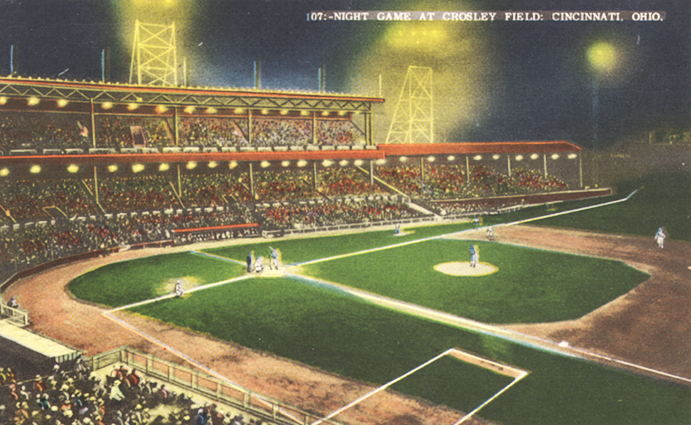
Night baseball debuted in the majors when Crosley Field erected eight towers with 600 bulbs in 1935. This postcard recreates the event. (The Rucker Archive)
Red, White and Truly Fanatical.
Once the lights settled in, Crosley Field strode into peak form for the next two decades. Capacity was increased to nearly 30,000 as the upper deck was extended in 1939 to each foul pole, a response to increased attendance as the Reds finally escaped the dark malaise of the Sidney Weil years and won back-to-back pennants—the latter of which led to their second world title in 1940 when they tipped the Detroit Tigers in a tight seven games.
The fans frequenting Crosley added their own healthy dose of color and character. The most famous and loyal among them was Harry Thobe, a walking Reds style guide whose usual attire consisted of a white straw hat, white suit, red tie, one white shoe, one red shoe, a red megaphone and a red-and-white parasol; legend has it that he flashed 12 gold teeth as well. Thobe often crashed the gate, sometimes with the help of the press, danced a jig in the stands and even on the field when Reds officials tolerated it. His fanaticism for the Reds stretched from the early League Park days of 1895 until his death in 1950.
Less frequent a visitor but no less memorable than Thobe was a young nightclub performer named Kitty Burke, who brought notorious levity to a near-riotous environment on July 31, 1935, the fifth night game in Crosley history. The largest crowd yet, some 10,000 above capacity, showed up—except that a good chunk of it came late due to mass transit issues. Their seats had already been scooped up by the earlier arrivals, who refused to give them back; arguments and some fights broke out. The situation was too much for Reds officials; Larry MacPhail fled the ballpark, and others locked themselves in their offices. That left it up to the police, umpires and a few unlucky Reds employees out in the open to square things up and create as orderly an overflow seating alignment as possible. With the Reds trailing the St. Louis Cardinals 2-1 in the bottom of the eighth, the crowd remained raucous, and it seemed the slightest spark of incivility could blow the whole place up. Out of the madness emerged Burke, who walked up to home plate and asked the Reds’ Babe Herman for his bat. Herman, stunned by the request, obliged; strangely enough, so did umpire Bill Stewart. Rarin’ to hit, Burke shouted at Cardinals pitcher Paul Dean to throw—which he did, a soft toss. Burke hit a meek infield grounder and was retired as, unofficially, the first female batter in major league history. The Cardinals argued that the out should have counted; instead, Herman retook the stage, doubled to extend a two-run rally, and the Reds won in 10 innings, 4-3.
Interaction with the ballplayers was something fans at Crosley Field were quite used to. The clubhouse was located in a separate building behind the third-base grandstand; to get to the field and back, players had to literally walk through the field level seats and concourse. Perhaps at times they felt a hankering for some of Crosley’s more popular concessions such as lemonade, bratwurst and, of course, beer, even at the risk of mingling with autograph hounds and verbal abusers. Fans were generally considered respectable toward the players passing through, though the whole concept must have given incentive for a visiting starting pitcher to not mess things up and avoid an early clubhouse shower—and the shower of potential heckling that might precede it.
Pitching Paradise Lost.
The extended Deadball Era at Crosley Field came to a close in 1938; something more akin to the Steroid Era soon followed. Home plate was moved 10 feet closer to the outfield wall, but then in 1942 the Reds brought in the fencing in front of the right-field bleachers by a whopping 24 feet, leaving a right-center gap that was never officially measured by couldn’t have been more than 350 feet. The lack of power in both the wartime baseball and replacement hitters delayed any splurge in home runs until after the war ended, and even then it seemed the visitors were doing most of the mashing. So midway through 1950, the Reds put the right-field fence back to its pre-1942 position—then brought it in again for 1953 when they sensed it would be more advantageous for their muscled-up roster. And boy, they weren’t kidding.
Only four times had a Reds player hit 20 or more home runs in the 71 years of Reds history prior to 1953. Over the next five years alone, it happened 18 times. The ballpark averaged nearly 200 homers a year during this short and lively period, well above the previous season record of 133 set in 1950. The Redlegs—as they were called during this time to avoid confusion with everything communist red—did most of the damage, peaking in 1956 when it tied a major league record (since broken) with 221 homers, 128 of which came at Crosley. Five separate Cincinnati players hit at least 28 that year, with four of them belting no fewer than 20 at home; Frank Robinson set a rookie record (also since broken) with 38, and left-handed slugger Ted Kluszewski—who intimidated pitchers by tearing off his sleeves and flexing his powerful muscles—added 35, capping an amazing four-year run in which he collected more dingers (171) than strikeouts (140). The right-field bleachers, nicknamed the Sun Deck—or the Moon Deck for night games—became a popular and busy place for home run souvenir collectors, and helped set the ballpark attendance record when 1,125,928 came streaming through the turnstiles in 1956 as the Redlegs ended an 11-year run below .500 and finished a mere three games behind Brooklyn for the NL pennant.
The aging brick buildings that nostalgically chewed the scenery beyond Crosley’s outfield walls represented the next line of defense for tape-measure shots. Behind left field, there was an ad atop the Superior Towel & Linen Service building for Siebler Clothing Store that promised a new suit if any batter struck it. The Reds’ Wally Post practically had to build a walk-in closet to make room for the 16 suits he won, the most among any player; the gratis wardrobe so embarrassed him that he once went into the store to buy three more suits. Among visiting players, Willie Mays fetched the most with seven. The billboard managed to stay in one piece despite being dinged a total of 147 times over 20 years, and Siebler managed to keep from going bankrupt in spite of all the free suits—though the publicity it gained was priceless.
The life was sucked out of the home run sock in 1957 when Kluszewski suffered a back injury that crippled his power. He was traded a year later and, through a sheer lack of coincidence, the Reds decided to move the right-field fence back yet again. The last fence movement in Crosley Field history tempered home run totals going forward, but the ballpark would retain its newfound reputation as a hitter’s yard through to its final days.
Oddly enough, some of Crosley Field’s greatest pitching feats took place after the field expense began to be reduced; of the eight no-hitters pitched at the ballpark, seven of them took place from after 1937. Two of them came on back-to-back days in 1969 when Houston’s Don Wilson responded in kind to the Reds’ Jim Maloney the day before. Clyde Shoun came the closest to a perfect game, allowing just one baserunner—a third-inning walk to Boston Braves pitcher Jim Tobin—in a 1944 game.
Auto Focus.
As beloved as Crosley Field was, it’s a small miracle that it lasted as long as it did without being replaced; a decade didn’t seem to go by without talk of a new ballpark or stadium. As early as 1926, the Reds looked into a new ballpark site in a more desirable spot of Cincinnati but couldn’t meet the lofty $500,000 price to purchase the land. In 1939, a combo domed stadium-arena project with echoes of the future Riverfront Stadium—it would have been built at the same location, with underground parking—was flatly rejected by city voters because of its $6 million price tag. Chatter yet again intensified in 1955 for a new ballpark—with one architect’s sketch idealizing something that looked surprisingly similar to Kansas City’s future Royals/Kauffman Stadium—but the conversation died short of the voters’ booth as confusion reigned on where to build it.
The eventual ruin of Crosley Field and the West End neighborhood where it sat would be the work of one thing and one thing only: The automobile.
Like most ballparks built in the steel-and-concrete era circa 1910, Crosley faced the postwar dilemma of where to put all the cars that most everyone now owned. The ballpark had parking for 2,000 cars, but the Reds by the mid-1950s wanted to increase that number to 8,000. When Powel Crosley bristled at the lack of progress from Cincinnati on the issue, he made his first public threats to sell the club, to outside interests if necessary—using as leverage rumors of a Reds move to New York to fill the void of the recently-vacated Dodgers and Giants. The city eventually approved a $2 million bond to add 2,600 spaces, well short of Crosley’s initial request yet still enough to placate him—but many businesses and residences were forcibly cleared to provide for the sea of ground parking lots surrounding the ballpark. Even the old Superior Towel & Linen Service building, with its famed Siebler Clothing Store ad, was brought down for the sake of 38 parking spots. It was a sad trade-off; parking was easier, but the neighborly charm was lost. As Chrissie Hynde sang some 25 years later: “My city had been pulled down, reduced to parking spaces…Ay, oh, way to go, Ohio.”
Another auto-related development further killed Crosley’s old-time romanticism. In the early 1960s, a wide swath of land beyond the outfield was cleared for construction of Interstate 75, part of the freeway’s long journey from Saint Ste. Marie, Michigan to Miami. Where Reds fans once viewed a city neighborhood now saw a vista of trucked-in dirt, construction vehicles and a lonely matrix of telephone poles. Oh yes, there were parked cars, too; officials allowed Crosley Field spectators to use the areas not under active construction. When the Reds made a long-awaited return to the World Series in 1961 to take on the mighty Yankees of Mickey Mantle and Roger Maris (the Reds lost, four games to one), freeloading fans who once used the top of the brick buildings to get a glimpse of the action now were sitting in the raised scoop of Caterpillar construction vehicles.
To shield potentially distractive construction activity to a minimum—especially for night games—the Reds went to desperate measures. They added height to the outfield walls, appending the existing walls with—legend has it—all the ping-pong tables they could find. At first, the added height was not in play as the Reds painted a line at the top of the original wall with anything hit above it being ruled a home run. But in a time without hi-def video reviews, umpires sometimes had difficulty determining if a deep fly actually hit just above or below the line. After a number of years and utter confusion, the Reds finally got rid of the line and allowed the entire wall to be in play.
Crosley Field in 1969, with the right-field bleachers prominent. The section of the outfield wall above the white line was added after the opening of Interstate 75, the moving traffic from which wrecked batters’ concentrations. (Wikimedia—Blake Bollinger)
While most other ancient ballparks on their last legs were left moribund and rotting, yearly improvements to Crosley Field during the 1960s kept the joint fresh even as a replacement stadium was knowingly on the way.
A huge new scoreboard, famously topped by a Longines clock, was put into use in 1957; its only drawback was that it never accounted for the possibility of a team scoring 20 runs, as the Reds did in its first season of use. Operators were left scratching their heads on how to show 2 for the second digit when it had been designed to either show “1” or nothing at all.
Other updates continued after the death of Powel Crosley in 1961. High-powered fans—yes, the kind that blow air—were strategically placed through the ballpark to keep spectators cool on hot summer days. A year-round gym, said to be the first of its kind in the majors, was built for the Reds under the stands. A new two-story ticket office was constructed. Original seats from the ballpark’s first days in 1912 were replaced, while less aging seats were painted, again and again. And in 1965, a strong glass backstop replaced the netting behind home plate, the first seen in the majors outside of San Francisco’s Seals Stadium, briefly used by the Giants after their move from New York.
Bill DeWitt, Powel Crosley’s successor, even went back to the ceaseless architectural firm of Hake and Hake—which had designed the original structure over 50 years earlier—to consider a massive redesign and reconstruction of Crosley Field, with an expanded upper deck, left-field bleachers, wider seats and better restrooms. When the tab for such a renovation proved too prohibitive, DeWitt shifted into Plan B—promising to spend a modest amount to improve the facility, but only if the city promised in return to pony up an additional 2,000 parking spaces. This time, the politicians yawned; Riverfront Stadium had all but been approved, and the Reds were looking at only a few more years at the old ballpark.
Crosley Field got an extended lease on life when construction delays at Riverfront Stadium kept it in use through the first half of the 1970 season. The Reds, in their first year under manager Sparky Anderson, made the most of it—winning 28 of the ballpark’s final 36 games before moving out. The last game itself was a beauty, a comeback effort in which Johnny Bench and Lee May led off the eighth inning with back-to-back home runs against San Francisco ace Juan Marichal to give the Reds a 5-4 win. The crowd of 28,000—including 98-year-old fan Hugh Hanley, who began watching the Reds way back in 1897—stuck around and watched closing ceremonies, which included a digging up of home plate to be transported by helicopter to Riverfront Stadium. Long-time Reds organist Ronnie Dale finished off the evening by performing Good Night, Sweetheart.
Bits and Pieces.
Crosley Field’s brief existence after baseball wasn’t pretty. The Reds and the City of Cincinnati armwrestled over how much the property was worth; a jury split a $2 million difference between both sides and the Reds received $2.5 million. Ironically, the ballpark whose charm and neighborhood equilibrium had been ruined by the automobile became, once in city hands, a place to imprison impounded cars. Demolition soon followed; on April 19, 1972, the ceremonial first swing of the wrecking ball was put into motion from a lever pulled by Pete Rose’s son.
From Crosley’s ruins, an industrial park was built and remains today, with some of its tenants having shown great respect for the once-hallowed grounds it occupied. The Phillips Supply Company used a small patio to layout a miniscule ballfield painted in green and dirt brown, surrounded by a small number of actual Crosley Field seats. When they got stolen, the company replaced them with seats from Riverfront Stadium; no one has yet bothered to take those. In a nearby alleyway, the actual location of Crosley’s home plate is marked with…a simple imitation of home plate. It’s all very anonymous. No fanfare, no inscription, no explanation. You could walk right over it and not even notice.
In 2015, the City Gospel Mission moved into a building where center field once was, paying homage to the ballpark with replicas of the foul poles, one of the light towers and, upon one of its walls, a 17×50-foot mural of Crosley Field as viewed from the first-base side of the upper deck.
The Cincinnati in Motion train exhibit includes a scale model of Crosley Field as it looked in 1940. It’s one of two complete models of the ballpark that can be seen in Cincinnati. (Flickr—Nick Massa)
Remnants of Crosley Field exist here and there. As the ballpark was being disassembled in the 1970s, an avid Reds fan named Larry Luebbers—whose son would eventually pitch for the Reds—bought 400 seats, part of the scoreboard, a ticket booth, turnstiles and various dugout items and put together a Field of Dreams-like ballyard in the middle of his farm in Union, Kentucky—attracting interest from Sports Illustrated and NBC Sports, which sent Joe Garagiola out for an interview. Northward, the Cincinnati suburb of Blue Ash, Ohio has made up for losing its long-ago bid to house a new Reds ballpark by building a replica of Crosley Field at a recreational sports complex. It includes the exact field dimensions, the warning track inclines, even a replica of the tall scoreboard, Longines clock and all, with the same lineups and out-of-town scores as listed for the ballpark’s final game in 1970. All that’s missing are 30,000 seats (it does have 400 others from Crosley), the entry facades and the brick buildings behind the outfield walls that gave Crosley so much of its atmosphere.
Reconstructed versions of Crosley Field do exist in whole—but on a much smaller scale. Mike Weaver, who grew up watching the Reds play their final years at Crosley, has spent four decades building, refining and re-refining an impressive scale replica of the ballpark circa 1970 that barely fit into his hatchback in order to be shown around the city in roadshow fashion. Another model, built to resemble the Crosley Field of 1940, is even more detailed—with fans, working lights and the surrounding neighborhood (including the Superior Towel & Linen Service building), all part of an eye-filling train exhibit at the Cincinnati Museum Center. Don’t rush to go see it, however; the museum is currently undergoing major renovation and isn’t scheduled to reopen until 2018.
It’s quite understandable, nearly 50 years after Crosley’s final baseball game, how the people of Cincinnati can express their longstanding loyalty to the old ballpark, a place that withstood floods, existed amid progress and witnessed the rot of a surrounding neighborhood in a city that, during its lifespan, was the smallest in the major leagues. Without it, there may not have been a Riverfront Stadium, or a Great American Ball Park that followed. Professional baseball was born in Cincinnati, and Crosley Field was the steel-and-concrete fabric that, locally, helped keep it alive.
 The Ballparks: Great American Ball Park The home of baseball’s First Team is not so much a ballpark but an array of inviting neighborhoods, a diverse riverfront community that embraces old and new alike and opens its patio to the Ohio River with charm to rival a Mark Twain novel. Want a peak? It’s easy to do from the water, and not much tougher from downtown thanks to the intriguing gap that allows fans to see the city and vice versa.
The Ballparks: Great American Ball Park The home of baseball’s First Team is not so much a ballpark but an array of inviting neighborhoods, a diverse riverfront community that embraces old and new alike and opens its patio to the Ohio River with charm to rival a Mark Twain novel. Want a peak? It’s easy to do from the water, and not much tougher from downtown thanks to the intriguing gap that allows fans to see the city and vice versa.
Cincinnati Reds Team History A decade-by-decade history of the Reds, the ballparks they’ve played in, and the four people who are on the franchise’s Mount Rushmore.


